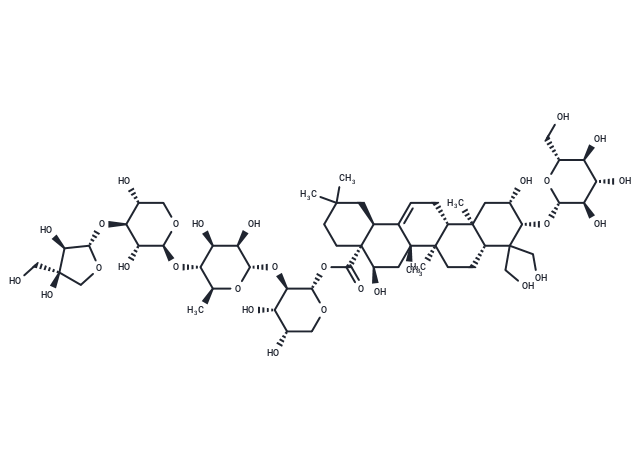Shopping Cart
- Remove All
 Your shopping cart is currently empty
Your shopping cart is currently empty

Platycodin D may stimulate TNF-α synthesis or inhibit degradation of TNF-α mRNA. Platycodin D (10/30 μM) suppresses prostaglandin E2 production in rat peritoneal macrophages stimulated by the protein kinase C activator 12-O-tetradecanoyl phorbol 13-acetate (TPA). Platycodin D and D3 are useful as expectorant agents in the treatment of various airway diseases, they can increase mucin release from rat and hamster tracheal surface epithelial cell culture and also from intact rat trachea upon nebulization.

| Pack Size | Price | Availability | Quantity |
|---|---|---|---|
| 5 mg | $52 | In Stock | |
| 10 mg | $89 | In Stock | |
| 25 mg | $155 | In Stock | |
| 50 mg | $238 | In Stock | |
| 100 mg | $397 | In Stock | |
| 500 mg | $893 | Backorder | |
| 1 mL x 10 mM (in DMSO) | $58 | In Stock |
| Description | Platycodin D may stimulate TNF-α synthesis or inhibit degradation of TNF-α mRNA. Platycodin D (10/30 μM) suppresses prostaglandin E2 production in rat peritoneal macrophages stimulated by the protein kinase C activator 12-O-tetradecanoyl phorbol 13-acetate (TPA). Platycodin D and D3 are useful as expectorant agents in the treatment of various airway diseases, they can increase mucin release from rat and hamster tracheal surface epithelial cell culture and also from intact rat trachea upon nebulization. |
| Molecular Weight | 1225.32 |
| Formula | C57H92O28 |
| Cas No. | 58479-68-8 |
| Smiles | C[C@@H]1O[C@@H](O[C@@H]2[C@@H](O)[C@@H](O)CO[C@H]2OC(=O)[C@]23CCC(C)(C)C[C@H]2C2=CC[C@@H]4[C@@]5(C)C[C@H](O)[C@H](O[C@@H]6O[C@H](CO)[C@@H](O)[C@H](O)[C@H]6O)C(CO)(CO)[C@@H]5CC[C@@]4(C)[C@]2(C)C[C@H]3O)[C@H](O)[C@H](O)[C@H]1O[C@@H]1OC[C@@H](O)[C@H](O[C@@H]2OC[C@](O)(CO)[C@H]2O)[C@H]1O |
| Relative Density. | 1.56 g/cm3 |
| Storage | Powder: -20°C for 3 years | In solvent: -80°C for 1 year | Shipping with blue ice. | |||||||||||||||||||||||||
| Solubility Information | DMSO: 45 mg/mL (36.73 mM), Sonication is recommended. | |||||||||||||||||||||||||
Solution Preparation Table | ||||||||||||||||||||||||||
DMSO
| ||||||||||||||||||||||||||

Copyright © 2015-2025 TargetMol Chemicals Inc. All Rights Reserved.